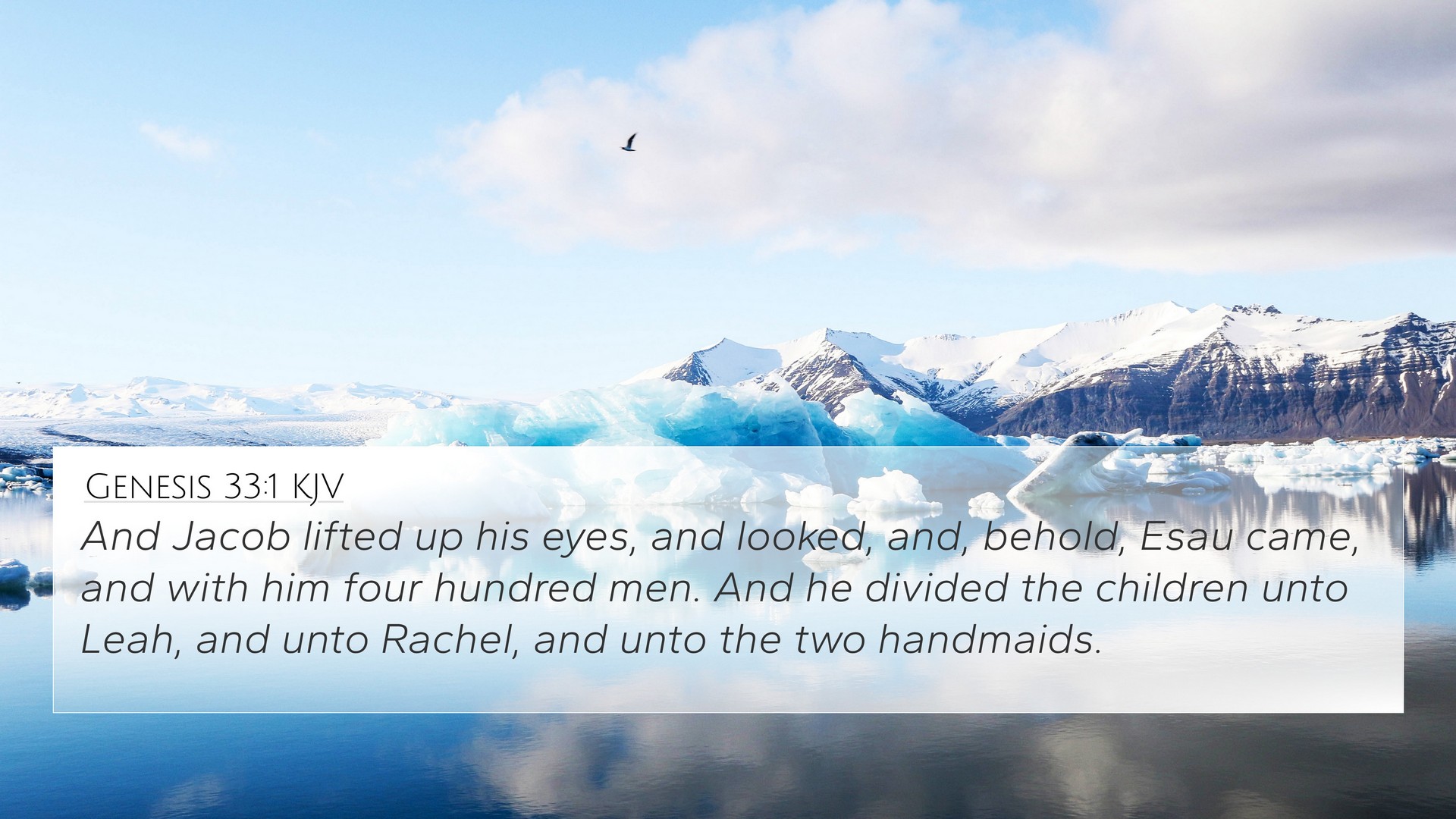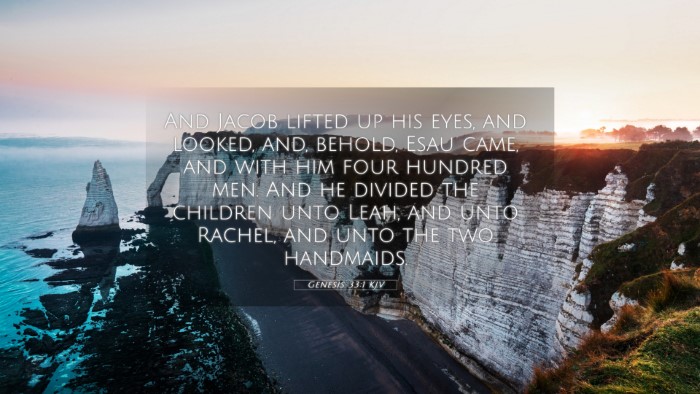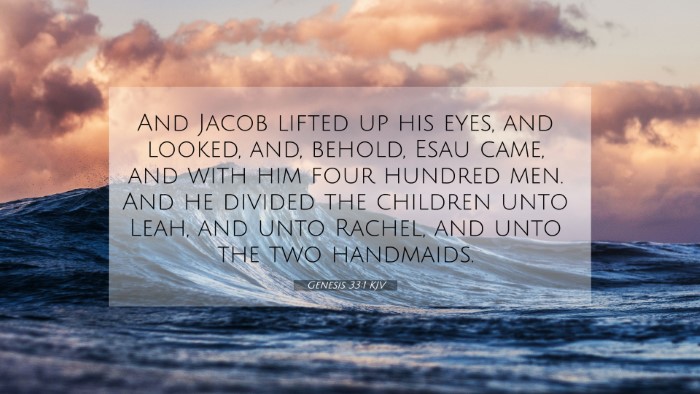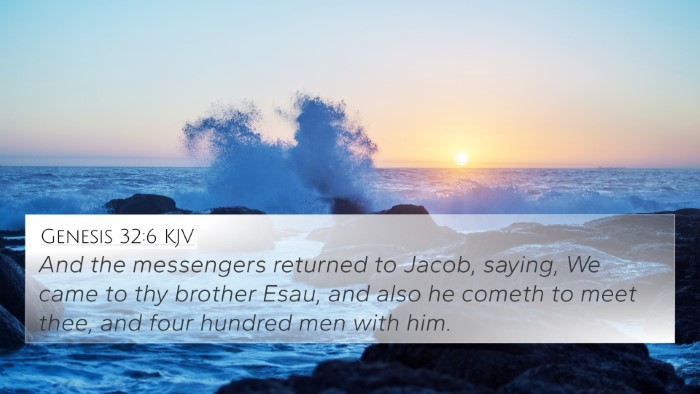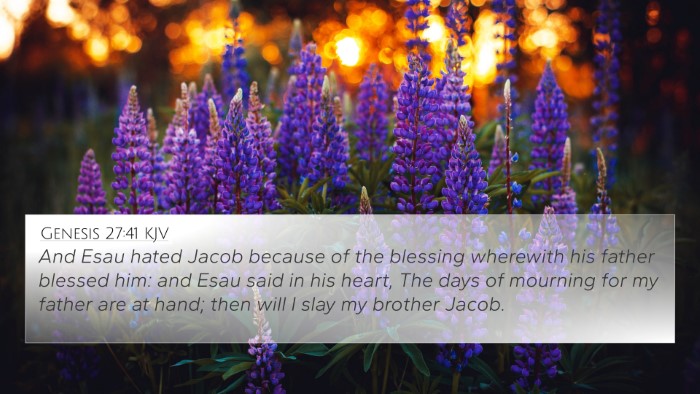Understanding Genesis 33:1
Genesis 33:1 states: "And Jacob lifted up his eyes and looked, and behold, Esau came, and with him four hundred men. And he divided the children unto Leah, and unto Rachel, and unto the two handmaids."
Summary of the Verse
This verse marks a pivotal moment in the narrative of Jacob and Esau, showcasing the reunion between the two brothers after many years of separation. It illustrates Jacob's preparedness to confront his brother, whom he had previously wronged, and sets the stage for their reconciliation.
Interpretation and Insights
-
Human Emotion and Conflict:
Jacob’s act of lifting his eyes signifies his awareness and acknowledgment of Esau’s presence, which is critical in human relationships, especially after conflict. It shows the weight of past grievances and the anticipation of potential reconciliation.
-
The Role of Family:
The division of the children among Leah, Rachel, and the handmaids highlights family dynamics at play. Each group's positioning reflects both Jacob's protective instincts as a father and his complex relationships with his wives.
-
Preparation for Encounter:
Jacob’s foresight in arranging his family signifies wisdom in facing potential danger or hostility. This strategic approach mirrors the human tendency to prepare for the worst while hoping for the best.
-
Symbol of Reconciliation:
The gathering of Esau with four hundred men indicates both a show of strength and an opportunity for reconciliation. It symbolizes the turning of enmity into peace, a central theme in many Biblical narratives.
Bible Verse Cross-References
Genesis 33:1 has notable connections to several other verses that illustrate broader themes of reconciliation and divine guidance:
- Genesis 28:15: God's promise to Jacob of protection and guidance during his journey.
- Genesis 32:9-12: Jacob’s prayer for deliverance from Esau’s wrath.
- Genesis 32:24-30: Jacob wrestles with God, reflecting his struggles and growth before meeting Esau.
- Genesis 27:41: Esau's initial anger towards Jacob, setting the stage for their encounter.
- Romans 12:18: Instruction to live peaceably with all, resonating with the theme of reconciliation.
- Ephesians 4:32: Encouragement to forgive one another, reflecting the spirit of Jacob’s intended reunion.
- Matthew 5:24: The importance of reconciliation before worship, paralleling Jacob's actions in preparing to meet Esau.
Thematic Bible Verse Connections
The themes of reconciliation and familial relationships echo throughout the Bible, illuminating Jacob's encounter with Esau:
- The recurring narrative of sibling rivalry and eventual reconciliation, as seen in Cain and Abel (Genesis 4:8).
- Jesus' teachings on forgiveness enhancing the understanding of Jacob’s actions (Matthew 6:14-15).
- David’s reconciliation with Saul's family (2 Samuel 9) serves as another parallel of seeking peace after conflict.
Comparative Bible Verse Analysis
Through the lens of comparative theology, we observe the connections between Genesis 33:1 and other scriptures:
- Luke 15:20: The father embracing the prodigal son reflects the theme of a joyful reunion, akin to Jacob and Esau's meeting.
- 1 John 4:20: Fostering genuine love and reconciliation resonates with the motivations behind Jacob's preparations.
- Jacob's humility in approaching Esau can be likened to Jesus' approach towards sinners and outcasts.
Conclusion
Genesis 33:1 serves as a profound narrative of fear transformed into peace, showcasing the human heart's capacity for reconciliation. The interplay of family dynamics, emotional depth, and spiritual insights underscores the importance of facing past grievances with courage and grace. As we explore the connections between this verse and many others, we better understand the overarching themes of conflict resolution, divine protection, and forgiveness that resonate through scripture.
